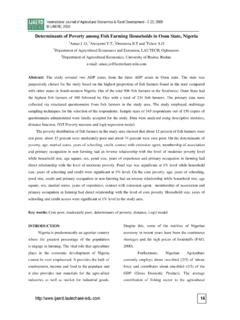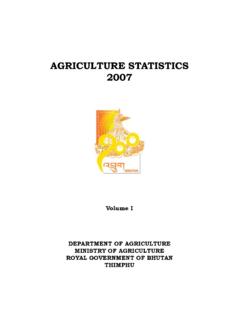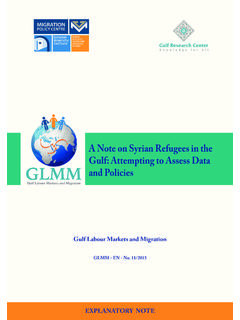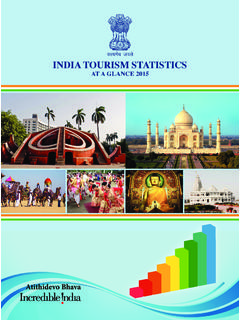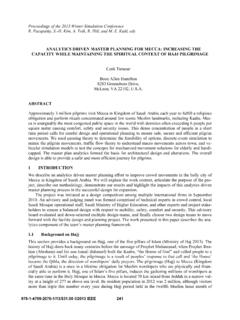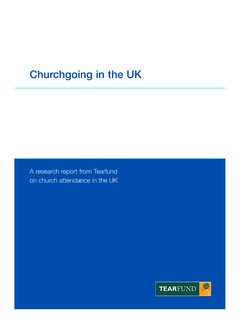Transcription of Nutritional components of Date palm and its production ...
1 83 International Journal of Agricultural Economics & Rural Development-4 (2): 2011 IJAERD, 2011 Produced by IJAERD Press-Nigeria, 2012 Nutritional components of date palm and its production status in NigeriaAbdulQadir, , , ,E. Economics Division, Nigerian Institute for Oil palm Research (NIFOR) Benin City, Edo Statee-mail: Nigerian date palm industry has the potential to generate employment and promoteeconomic development. date palm is one of the greatest producers offood per hectare producing more than3000 calories per Kg. The review shows that the highest producers of Dates are Egypt, Iran and SaudiArabia with an annual production statistics of 1,326,000MT, 1,000,000MT and 982,000MT respectively asat 2008.
2 In Nigeria annual Dates production in the country is over 21,000MT. date are nutritious,assimilative and energy producing. Dates contain K, Ca, Mg, Fe, Cu, Zn, Mn and very low quantities of Si,S and fat it is called a is grown in Nigeria from latitude 100 North in the SudanSavanna to the Sahel regions, despite its Nutritional importance the production of the crop is still restrictedto compound and is also dearth of information on the statistics of date production inNigeria as well as low rate of awareness on its Nutritional and economic importance. Therefore this paperunveils the statistics of Dates production in the country, as well as the Nutritional importance of date .
3 Thiswill enhance awareness creation of itspotential and economic development in the country. However theconcerned of private sectors are required for the accelerated development of the : Employment generation, calories per Kg, assimilative, dearth of information, unveils,accelerated date palm (phoenix dactylifera .L)is produced mainly in the hot arid regions ofSouthern Asia and North is probablythe most ancient cultivated tree crop in the world(Zaid and Wet, 1999). date productioninNigeria started at about 17thcentury ago but itscultivation and marketing has been subsistencelevel.
4 Omamoretal (2000) reported that pilgrimsbrought date palm in to Nigeria from NorthAfrica during trans-Saharan trade and from theMiddle East. Though Nigeria is not a majorDates producer in the world, the crop strives inNorthern parts of the country particularly regionsabove latitude 100 North of the equator Okolo etal (2000). It is propagated by seed, offshoot andtissue , tissue culture has beenfound to be the best method of propagation forcommercial planting and true to type of thecharacteristics of the mother Datepalm is dioecious perennial, the females ofwhich normally begin to bear date fruits afterfour years depending on the agronomic is a monocotyledonous plant with no tap rootbut fibrous root system.
5 The trunk is vertical andcolumnar of the same girth all the way up. Thegirth does not increase once the canopy of frondshas fully developedexcept the terminal budexperiences an abnormal growth caused by anutritional deficiency or drought conditions,84 Journal of Agricultural Economics & Rural Development-4 (2): 2011 IJAERD, 2011which will lead to shrinkage of the growth of date palm is ensured by itsterminal bud calledphyllophorand its heightcouldreach 20m (Zaid and Wet 1999). The trunkand leaves of the date palm are similar to thoseof Oil palm. The fronds (Leaves), with averagelength of 4 metres carry the spines and theleaflets.
6 The fruit is single, Oblong, one-seededberry with terminal stigma, a fleshpericarpanda membranous the invaluable roles of Dates inhuman life, the Nigerian date palm industry( production ,processingandmarketi ng)isbeleaguered with the following of information on the status ofthe Nigerian date palm of awareness on the nutritionalimportance of of the study:The main objective of this study is tocreate awareness on the potentials of theNigerian date palm specific objectives disclose the statistics of annual Dateproduction in Nigeria and the unveil the Nutritional components data were used for this data were collected from NIFOR annualreport, NIFOR sub-station Dutse,FAO statisticaldata base and other related production in NigeriaThe date palm is believed to have beenintroduced into Nigeria in the early 17thcenturythrough the trans-Sahara trade route from NorthAfrica and Muslim pilgrims on pilgrimage to theHoly cities of Mecca and Medina (Omamor et al2000)
7 Although date palm has economic, socialand religious values in the Sudan-Sahel Savannaregion of Nigeria, its cultivation has remainedrestricted to compounds, homesteadand feworchards in the northern parts of the palm is grown in northern Nigeriaincluding Kaduna, Katsina, Kano, Sokoto, KebbiJigawa, Yobe, Borno, Gombe, Bauchi andAdamawa states including Plateau,Taraba, Nassarawa, SouthernKaduna and NigerState could be classified as marginal areas forDate palm cultivation in the in Nigeria has two fruiting seasons(dry and wet seasons fruits), but only the dryseason fruit is economically theabundant land resource the country is stillincreasingly dependent on dates import to meetlocal statistics of annual Datesproduction in the country from the studied statesdeduce so far is over 21,000 MT from theavailable data as shown figure isinsignificant compared to local demand in a result, the nation resorts to Datesimport to meet local demand.
8 This shows that themarket prospects of Dates in Nigerian are 1: statistics on annual Dates production inNigeriaS/NStatesAnnualproductioninMetr ics Tone (MT)1 Adamawa2002 Bauchi6,0003 Borno10004 Gombe1,5005 Jigawa5,0006 Kano6,0007 PlateauInsignificant8 TarabaInsignificant9 Yobe2,00010 Kaduna-85 International Journal of Agricultural Economics & Rural Development-4 (2): 2011 IJAERD, 2011 Produced by IJAERD Press-Nigeria, 201211 Nasarawo-12 Katsina-13 Zanfara-14 Kebbi-15 Sokoto-Total21,700 (MT)Dates production in production in Africa was MT in 2001 and million MT in is the highest Dates producer in Africa asat2005 followed by Algeria and Sudan withannual production statistics of 1, 117,000 MT,516,293MT and 328,200MT respectively (FAOS tatistics) Table West Africa, Mauritania is thehighest Dates producer as at 2005 followed byChad and Niger with annual production figuresof22,000MT,15,000 MTand8,000 MTrespectively (Table 4.)
9 FAO statistics 2008).Nigeria is not listed among the Dates producersat the international is attributed todearth of information on the Nigeria date 2: Major DatesProducers in the World in 000MT (1999 2008)Country1999200020012002200320042005 200620072008 Egypt1,1131,1131,1131,0901,1221,1661,170 1,3291,3141,326 China120120120133123128134125130135 Iran875875875879885990998100010001000 UAE758758758758759815859---Iraq650650650 866868875404432440440 Pakistan630630630625427622497426557680 Algeria437418437418472443516491526500 Sudan330330330330328336328328--Oman23923 9298239220231247259256256 Libya140140140200200150180170175175 Saudi A818818818830884941970977982982 Tunisia113113113120117122125125--Source.
10 FAO statistics Division 2008 World dates productionWorld Dates production (as shown inTable 2) was million MT in 1999 and (FAO,2008). The major Dates producers in theworld are situated in the Middle East and NorthAfrica. date is probably the most ancientcultivated tree crop in the world (Zaid and Wet,1999). FAO statistical data showed that the tentop producing countries as at 2008 were Egypt( MT), Iraq ( MT), Iran ( MT),Qatar ( MT), Pakistan ( MT), Algeria( ,MT), Saudi Arabia ( MT), China ( ),Oman ( MT) and Libya ( MT). Egyptremains the largest World producer of Dates asat 2005 ( ).
